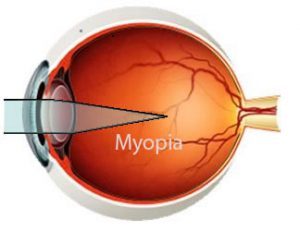- Home
- Editorial
- News
- Practice Guidelines
- Anesthesiology Guidelines
- Cancer Guidelines
- Cardiac Sciences Guidelines
- Critical Care Guidelines
- Dentistry Guidelines
- Dermatology Guidelines
- Diabetes and Endo Guidelines
- Diagnostics Guidelines
- ENT Guidelines
- Featured Practice Guidelines
- Gastroenterology Guidelines
- Geriatrics Guidelines
- Medicine Guidelines
- Nephrology Guidelines
- Neurosciences Guidelines
- Obs and Gynae Guidelines
- Ophthalmology Guidelines
- Orthopaedics Guidelines
- Paediatrics Guidelines
- Psychiatry Guidelines
- Pulmonology Guidelines
- Radiology Guidelines
- Surgery Guidelines
- Urology Guidelines
Drugs could one day treat myopia, reveals gene study

A new study published in the journal PLOS Biology reported that myopia (near-sightedness) and hyperopia (far-sightedness) develops through different molecular pathways. The findings suggest that the development of myopia and hyperopia involves different genes and cell signaling pathways which provided a new understanding of myopia, and opens the way for the development of drugs to prevent it.
Prior to this, it was assumed that "opposite changes in the same genes and pathways" determined how the two eye conditions developed after birth.
Read Also: Specially Designed Lens Slows Down Myopic Progression in Children
There is evidence that both genes and environmental factors, such as spending more time reading, using computers, stress can increase the risk of myopia. Before this study, however, it was not clear what the underlying molecular mechanisms were.
To explore those pathways, Tkatchenko et al.induced either myopia or hyperopia in marmosets, by placing lenses in front of their eyes. A lens that shifts the focal point to behind the retina ("hyperopic defocus") induces myopia, while one that shifts it to in front of the retina ("myopic defocus") induces hyperopia. In each case, the eye changes shape, elongating or shortening, to compensate by moving the retina closer to the focal point.
When marmosets were exposed to defocus of either type in one eye for up to 5 weeks, the activity of genes in the exposed retina changed compared to the non-exposed retina (used as a control). The authors found that both types of defocus induced changes in important cellular signaling pathways, with the scores of genes affected in each case but only a small handful were affected by both types of defocus. There were also gene activity differences over time in each type, with little overlap between those affected within the first 10 days and those affected after 5 weeks.
Read Also: Glaucoma drug halts myopia progression- study
The investigators also found that 29 of the genes that changed expression were in the same chromosome regions that large genetic studies have linked to myopia in humans suggesting that variations in the expression of genes involved in the normal regulation of eye shape in response to defocus contribute to nearsightedness.
The results of this study show that the retina can distinguish between myopic and hyperopic defocus and responds to defocus of opposite signs by activating largely distinct pathways.
"Identification of these pathways provides a framework for the identification of new drug targets and for the development of more effective treatment options for myopia," said Tkatchenko.
According to the World Health Organization (WHO), there is an upsurge in myopia prevalence worldwide, with an accompanying increase in risks of serious eye conditions such as cataract, retinal damage, and glaucoma. The researchers believe that by 2050, the number of people affected by myopia will reach 4.8 billion, or around half of the global population and that the WHO ranks it among the world's "five priority health conditions."
For reference log on to https://doi.org/10.1371/journal.pbio.2006021

Disclaimer: This site is primarily intended for healthcare professionals. Any content/information on this website does not replace the advice of medical and/or health professionals and should not be construed as medical/diagnostic advice/endorsement or prescription. Use of this site is subject to our terms of use, privacy policy, advertisement policy. © 2020 Minerva Medical Treatment Pvt Ltd